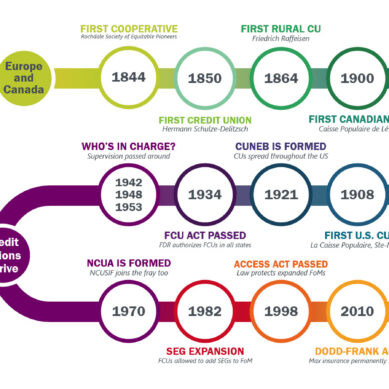WordPress, the state-of-the-art content management system (CMS) that powers over 40% of all websites, has been a transformative force on the web since its creation back in 2003. Originally created as a blogging platform, it has evolved into a CMS that powers anything from personal blogs to enterprise-level websites.
As technology continues to advance at a rapid pace, what does the future hold for WordPress? Let’s take a peek into the looking glass and find out!
Lincoln Logs and Legos
A key area where WordPress is expected to evolve is in providing an even more intuitive and seamless user experience. With the continued rise of no-code and minimal-code solutions created by page builders such as Elementor, Beaver Builder, and Divi, users increasingly expect a simple and easy-to-use backend.
The native, built-in page builder for WordPress—Gutenberg (introduced in WordPress 5.0)—was a significant step towards this goal and doesn’t require any additional plugins. Gutenberg offers a block-based editing experience.
As a Web Developer, I currently utilize Gutenberg to create blocks and features in-house for client websites, providing custom solutions for the ever-changing web. In the future, we can anticipate further refinements to the Gutenberg editor, enabling users to create complex layouts effortlessly and intuitively. Gutenberg helps provide more creative power and control to users.
Skynet
Advancements in Artificial Intelligence (AI) will likely play a significant role in enhancing user experience. It seems like everywhere you look today, someone is implementing AI into their offerings. AI-powered features could include intelligent content suggestions, automated formatting, and personalized user interfaces tailored to individual preferences.
For example, Elementor has implemented AI into its page-building plugin, offering content and code generation, layout and image enhancement, and other AI features.
I have spoken previously about credit unions utilizing AI to create relevant content for their website. By leveraging AI implemented directly into WordPress, WordPress can empower users to create customized content more efficiently while delivering personalized experiences that resonate with their audience, all while never visiting an outside website to do so.
AI-based automation will help developers streamline repetitive tasks, freeing up time to focus on other strategic initiatives. Automated testing and deployment pipelines can ensure faster and more reliable updates to both the WordPress core and various plugins. Properly implementing automation can help your WordPress website become more efficient, adaptive, and user-friendly than ever before.
The Headless Horseman
The concept of headless CMS has been becoming more popular in recent years. While it may sound like a Halloween story or a character from Harry Potter, a headless CMS works by separating the content management backend from the frontend presentation layer.
While WordPress traditionally operates as a single system, headless WordPress allows developers to leverage the CMS purely for content creation and management. This also allows developers to use any frontend technology they prefer, such as a modern Javascript framework. This approach offers greater flexibility, scalability, and performance—making it an appealing option for developers building modern web applications.
In the future, we can expect headless WordPress to become more accessible and user-friendly, with streamlined workflows and enhanced developer tools. Improvements in RESTful API capabilities will enable seamless integration with a wide range of front-end frameworks and technologies. These technologies empower developers to create more dynamic and interactive experiences that push the boundaries of web design and development.
Safe and effective
In an era of seemingly continuous cybersecurity threats, security remains a paramount concern for website owners. Ever-increasing user expectations for fast-loading websites also put performance at the top of the list of important website features.
Future iterations of WordPress are likely to place even greater emphasis on both of these aspects. With built-in features for caching, code optimization, and security enhancements, WordPress continues to improve its platform. Tighter integration with web hosting providers and CDN services could further streamline the process of optimizing website performance and fortifying website security.
Advancements in serverless architecture and edge computing could change the way WordPress handles resource-intensive tasks such as image processing and content delivery. By using distributed networks to offload these tasks, WordPress can deliver faster load times with improved scalability, and not compromise on security or reliability.
Virtually augmented things
As technology continues to evolve, WordPress needs to adapt to stay relevant. This includes seamless integration with emerging technologies such as virtual reality (VR), augmented reality (AR), and the Internet of Things (IoT).
By embracing these technologies, WordPress can continue to serve as a versatile platform for building innovative digital experiences. While technologies like VR and AR have been around for more than a decade, we have yet to see the real potential of these technologies outside of niche applications. Hopefully, in the near future, that will change.
Future advancements in natural language processing and voice recognition could enable new modes of accessible interaction with WordPress by allowing users to create and manage content through spoken commands or conversational interfaces. A greater diversity of options for content creation and generation assists users from a broad range of backgrounds.
By staying at the forefront of technological innovation, WordPress can deliver cutting-edge digital experiences that captivate and engage their audience.
Staying mobile
With the ever-growing market share of mobile devices, making sure WordPress continues to be optimized for mobile devices will stay at the forefront of improvements. While responsive design and a mobile-first approach have been common for almost a decade, theme makers and plugins will be increasingly mobile-friendly.
Our website developers have been providing responsive design for all websites for quite some time and will continue to emphasize the mobile web in the future. We could also see a WordPress mobile app that allows for designing and building websites on the go, or we could see mobile apps using WordPress as a backend to power their app.
Plugins galore!
One of the biggest strengths of WordPress is the vast amount of plugins available for websites. New plugins are added to the official WordPress plugin directory daily, totaling over 60,000 plugins! Popular plugins such as WooCommerce and Jetpack are found on many WordPress sites. My team specifically utilizes security plugins as well as our own custom plugins for credit union sites.
An ever-growing trend in plugins is specific plugins tailored to certain industries and use cases, like LearnDash LMS for virtual classes. There are also many paid/pro plugins available if what you’re looking for is not included in the official WordPress plugin directory. As the importance of accessibility continues to spread, plugin developers are also rapidly improving the accessibility of their creations. Expect this trend to continue as innovation grows and more niche markets are found.
Speaking your language
WordPress language options have often been a topic that has come up repeatedly in web development. While trying to serve various communities, our credit union clients have needed multiple language options.
Going forward, WordPress has expressed a commitment to serving a global community, and thus improving its multilingual support. The integration of this support is expected to occur in late 2024, or early 2025. Previously, this behavior was typically handled by a Google Translate plugin or the user’s web browser itself, so having language features baked into WordPress itself is a welcome addition.
Come together
In my opinion, WordPress’s greatest strength is in its large community of developers, designers, and users who contribute to its continued growth and evolution.
As we look to the future, community-driven innovation will continue to play a crucial role in shaping the direction of WordPress. With both grassroots initiatives and official contributions, the collective wisdom and creativity of the WordPress community will drive the platform forward, ensuring that it remains at the forefront of web development for years to come.
The final countdown
The future of WordPress is both impressive and hopeful. Exciting developments are on the horizon that promise to further enhance its capabilities and solidify its position as the leading CMS on the modern web.
From better user experiences via Gutenberg and blocks to AI and automation, headless architectures, growing mobile support, new plugins being added daily, multilingual integration coming soon, and integration with emerging technologies, WordPress is set to evolve step-in-step with the always-evolving landscape of the web.
By staying true to its open-source roots and embracing innovation, WordPress will continue to empower millions of users worldwide to create, share, and connect in the next phase of the web.


























































